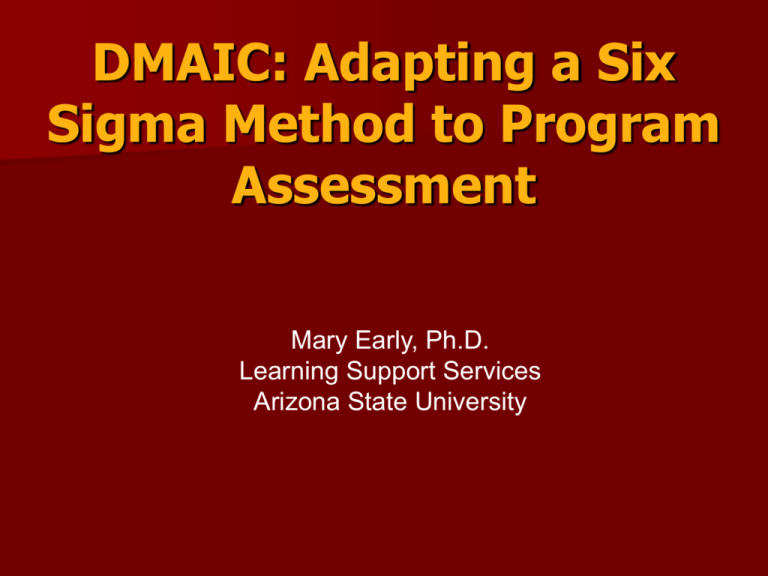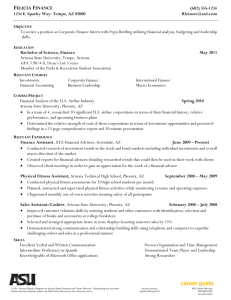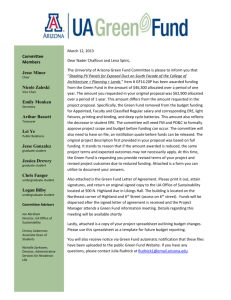DMAIC: Adapting a Six Sigma Method to Program
advertisement

DMAIC: Adapting a Six Sigma Method to Program Assessment Mary Early, Ph.D. Learning Support Services Arizona State University Six Sigma Pioneered by Bob Smith at Motorola in 1986 Metric for measuring defects & improving quality 6 = a defect rate < 3.4 per million Customer-focused, fact-based, datadriven, problem-solving methodology Learning Support Services, Arizona State University, 2007 Applying DMAIC to Student Affairs DMAIC, a process developed through Six Sigma, is a cycle of continuous improvement DMAIC consists of five steps: – Define – Measure – Analyze – Improve – Control Learning Support Services, Arizona State University, 2007 Continuous Improvement: DMAIC DEFINE CONTROL MEASURE IMPROVE ANALYZE Learning Support Services, Arizona State University, 2007 Applying DMAIC to Student Affairs Define (set objectives of improvement project): – Develop program- and department-level student learning outcomes – Assess achievement of SLOs Measure (collect data to establish baseline): – What SLOs are in place now? – Where are SLOs missing? – What assessment strategies are in place? Learning Support Services, Arizona State University, 2007 Applying DMAIC to Student Affairs Analyze (find opportunities to improve the current state): – Brainstorming session – Program outcomes – Data dump Learning Support Services, Arizona State University, 2007 Sample Template for Program SLOs Program: Tutoring Learning Outcome Assessment Time(s) of Method(s) Assessment Collection Agent Application of concept Tutor observation During tutoring session Tutor notes Acquisition of learning skills Tutee evaluations Midterm and Evaluation end of semester forms Improved grades Compare grades After grades are of tutored/nonposted tutored members of classes Data WareHouse Adapted from Gloria Rogers, ABET, Inc. Learning Support Services, Arizona State University, 2007 Data Dump Content knowledge Acculturation to the university Self-knowledge Application of skills/strategies Information and technology literacies Engagement/involvement Application of skills and strategies Collaboration Self-management Personal reflection Self-awareness Personal responsibility/ accountability Critical thinking Communication skills Culture of classroom Campus resources Interpersonal relationship building Learning Support Services, Arizona State University, 2007 Applying DMAIC to Student Affairs Improve (develop creative solutions) – Compare and combine data into “envelopes” – LSS developed three envelopes of shared departmental goals: ־Academic competencies ־Life-skills development ־Social competencies Learning Support Services, Arizona State University, 2007 Learning Support Services’ SLO Envelopes Academic Competencies – Content knowledge – Application of skills/strategies – Critical thinking – Information and technology literacies Learning Support Services, Arizona State University, 2007 Learning Support Services’ SLO Envelopes Life-Skills Development – Application of skills and strategies – Critical thinking – Self-awareness/knowledge – Personal reflection/awareness – Personal responsibility/accountability – Self-management Learning Support Services, Arizona State University, 2007 Learning Support Services’ SLO Envelopes Social Competencies – Communication skills – Acculturation to ASU – Culture of classroom – Campus resources – Interpersonal relationship building – Engagement/involvement – Collaboration Learning Support Services, Arizona State University, 2007 Working Documents Three files serve as the SLO envelopes on our department’s shared drive Each program coordinator contributed learning outcome statements and measures/assessments to pertinent files (academic, life-skills, and social competencies) Learning Support Services, Arizona State University, 2007 SLO Example Academic competencies example for peer mentoring: – Statement: Students will learn concepts related to leadership, peer education and mentoring, communication, group dynamics, and diversity, as well as familiarizing themselves with campus programs and services that support academic and co-curricular student success. – Measures: Student self-reflection through journals and classroom discussion, instructor observation, course grades, pre- and post-surveys, mentee and coordinator evaluations. Learning Support Services, Arizona State University, 2007 Applying DMAIC to Student Affairs Control (maintain improvements) – Administer evaluations – Assess success – Commit to modifying SLOs next year Learning Support Services, Arizona State University, 2007 Questions? Presentation materials will be available through the NASPA website (www.naspa.org) ASU’s Continuous Improvement website: www.west.asu.edu/tqteam Contact information: Mary Early, Ph.D. Learning Support Services Arizona State University mary.early@asu.edu (480) 965-5261 www.asu.edu/lrc Learning Support Services, Arizona State University, 2007








